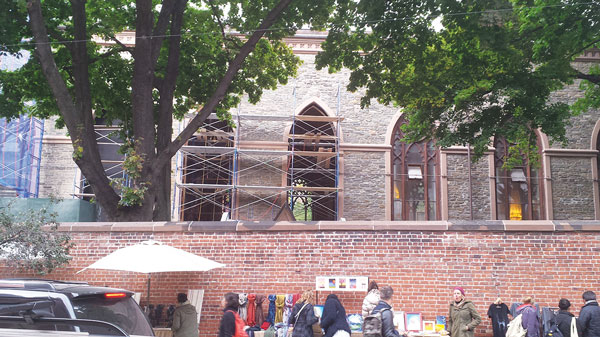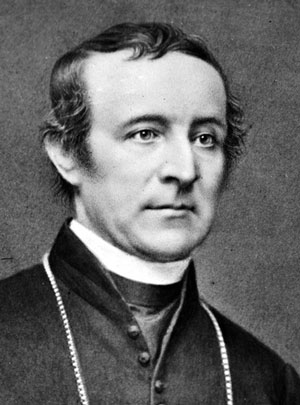
BY ALBERT AMATEAU | St. Patrick’s Old Cathedral, at the corner of Mott and Prince Sts., is becoming new again as a major renovation project draws to completion in time for the celebration of its 200th anniversary.
Because it took six years to build the cathedral, the bicentennial is a six-year event that started on June 7, 2009, commemorating the laying of the church cornerstone in 1809. The climax of the celebration, “Embracing the Future as We Celebrate Our Past,” will be at a vespers service on Sun., Nov. 22.
Monsignor Donald Sakano, appointed pastor of Old St. Patrick’s in 2007, has been in charge of planning the bicentennial and of overseeing the $16 million renovation of the venerable church, which was awarded basilica status in 2010.
“It’s been a huge restoration project and we’re not quite finished yet. From where I sit, I can see workers installing a stained-glass window,” Sakano told The Villager in a telephone interview at the end of October. “We’ll have the celebration on time even if there might be a few things left to do,” he assured.
The old cathedral, more than 120 feet long, 80 feet wide and 75 feet tall, was designed by Joseph Mangin, a French-born architect who was also co-designer of City Hall. At the time, it was the city’s largest church building and second Catholic church.
Situated between Mott and Mulberry Sts., St. Patrick’s occupied land on the city’s outskirts that served as the cemetery of the city’s first Catholic church, St. Peter’s on Barclay St. in Lower Manhattan. In 1808, the year before the cornerstone was laid, Pope Pius VII had established the Diocese of New York, which included the entire state and part of northern New Jersey.
Because of the Napoleonic Wars in Europe, the first bishop of New York, Irish-born Richard Concanen, never reached his diocese. He died in Italy in 1810. So the building of the cathedral was supervised by Father Antony Kohlmann, an Alsatian-born Jesuit.
The cathedral opened on Ascension Day, May 4, 1815, with a crowd of 4,000 worshipers and guests, including Mayor DeWitt Clinton. But it wasn’t until November that the second bishop of New York, John Connolly, an Irish Dominican theologian, arrived to officially dedicate the new cathedral.
“We’re the oldest Catholic church building in New York,” said Sakano of the newly restored church. “St. Joseph’s Church in the Village makes the claim because we are now a basilica, and they’re a simple parish church,” he added.
The original St. Peter’s Church on Barclay St., built in 1786, was destroyed in the great fire of 1835, which burned for days and was visible at night from as far away as Philadelphia, according to some sources at the time. St. Peter’s was replaced with a granite church in 1840.
Fire nearly destroyed the original cathedral in October 1866 when sparks from a packing crate blaze in a Crosby St. building set fire to the roof of the church. The five-alarm fire left only the outer four walls standing.
The then-archbishop, John McClosky, born in Brooklyn to Irish immigrant parents, resolved to reconstruct the cathedral quickly. It reopened with an elaborate new interior designed by Henry Engelbert on St. Patrick’s Day, 1868.
The rebuilt roof was derived from a design by James Renwick, architect of the new St. Patrick’s Cathedral on 51st St. and Fifth Ave., which was under construction by then on a property acquired in 1810 for a Jesuit school.

The cornerstone of the new uptown cathedral (scoffers dubbed it “Hughes’s Folly”) was laid in 1858 by Archbishop John Joseph Hughes, who emigrated from Ireland to the U.S. in 1817. He entered the priesthood in 1826, served in Philadelphia and arrived in New York in 1838. He served as an administrator of the diocese and was consecrated bishop in the old cathedral in 1842 on the death of Bishop John Dubois.
“The real hero of the story is John Hughes,” said Sakano. “He was known as ‘Dagger John’ because bishops signed their names with a cross, which took the shape of a dagger in newspapers. He was a pugnacious orator who defied nativist anti-Catholic mobs.”
A brick wall had been built around the cathedral as protection from nativist attacks. Over the next several years, mobs had descended on St. Patrick’s but turned back after learning that armed defenders were posted by Bishop Hughes along Prince St. and behind the brick wall.
In 1844 after the anti-immigrant James Harper was elected mayor of New York and a mob threatened to march on the cathedral, Hughes organized a small army of Irish immigrants to defend the church. He then sent a letter to Harper warning that if any harm came to a single Catholic or to a Catholic church, the city would turn into “a second Moscow,” referring to the burning of that city in response to Napoleon’s 1812 invasion. Hughes’s actions are credited with turning back violence.
During the Civil War, Hughes served as an envoy of President Lincoln to dissuade European nations from supporting the Confederacy. In gratitude, Lincoln petitioned Pope Pius IX to name Hughes as the nation’s first cardinal. But Hughes died in 1864 before a nomination could take place.
“We’ll be dedicating a monument to Bishop Hughes in front of the church on Nov. 22,” Sakano said. The 12-foot-tall bronze column topped by a bust of Hughes, designed by Rowan Gillespie, an Irish sculptor, will be unveiled at the 3:30 p.m. ceremony. Visitors will then be invited to tour the 200-year-old restored church.

















